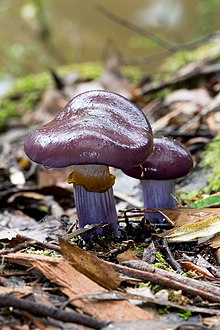Cortinarius
| Cortinarius | |
|---|---|
 |
|
| Cortinarius archeri | |
| Scientific classification | |
| Kingdom: | Fungi |
| Division: | Basidiomycota |
| Class: | Agaricomycetes |
| Order: | Agaricales |
| Family: | Cortinariaceae |
| Genus: |
Cortinarius (Pers.) Gray (1821) |
| Type species | |
|
Cortinarius violaceus (L.) Gray (1821) |
|
| Diversity | |
| ca. 2000 species | |
Cortinarius is a genus of mushrooms. It is suspected to be the largest genus of agarics, containing over 2000 different species and found worldwide. A common feature among all species in the genus Cortinarius is that young specimens have a cortina (veil) between the cap and the stem, hence the name, meaning curtained. Most of the fibers of the cortina are ephemeral and will leave no trace once gone, except for limited remnants on the stem in some species. All have a rusty brown spore print. The common names cortinar and webcap refer to members of the genus. Due to dangerous toxicity of several species (such as Cortinarius orellanus) and the fact that it's difficult to distinguish between various species of the genus, non-expert consumption of mushrooms from the genus is discouraged.
The veil protects the gills in younger specimens and usually disappears leaving little to no trace of itself as the mushroom grows. The spores of a Cortinarius mushroom are rusty brown to brownish red in color. It is usually possible to identify a mushroom as being a member of the genus, but extremely difficult to positively identify the species as many of the species are nearly identical. All mushrooms in this genus form mycorrhizae.
Many mushrooms in the genus—for example Cortinarius sanguineus and other species in section Dermocybe—are colourful and are often used for dyeing.
Several mushrooms in the genus Cortinarius are poisonous, mainly because they cause acute tubulointerstitial nephritis. Some are even lethal, such as Cortinarius rubellus and Cortinarius orellanus. Therefore, a common rule when it comes to mushrooms from this genus is that none of them should be eaten. However, some species—notably the giant of the genus, Cortinarius praestans and the gypsy mushroom (Cortinarius caperatus)—are edible and appreciated in several European countries.
...
Wikipedia
